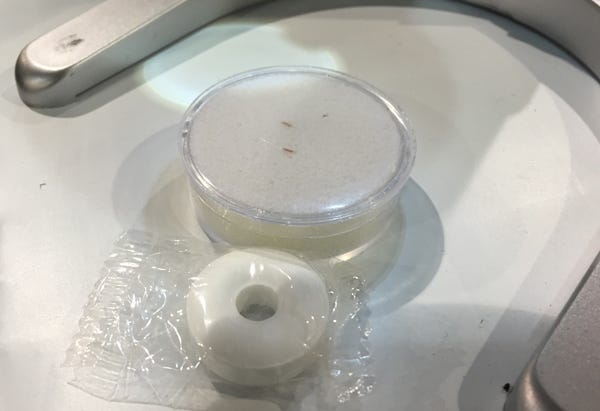This Is How You Solder Tiny Catheter Coils
October 12, 2015
How did Classic Coil Co. solve a manufacturing challenge related to tiny copper wire coils for catheter tips? It came down to three words: trial and error.
Chris Newmarker
|
The tiny copper catheter tip coils look like brown fleas when lined up next to a breath mint. (Photo taken at MD&M Philadelphia by Chris Newmarker) |
Medical device companies approached Classic Coil Co. with an interesting manufacturing challenge seven years ago: They wanted to attach tiny copper coils to the tips of super-thin 6- to 8-ft-long catheter lead wires.
The coil would help provide an "internal GPS" of where the catheters were in the body, but it needed to be connected to a lead first, Jeff Folkins, vice president of sales at Classic Coil (Bristol, CT), explained Thursday at MD&M Philadelphia.
|
Jeff Folkins |
"I have to connect it to a device that has all the sensors, and that might be 6 to 8 feet away," Folkins said.
The connection needed to take place at wire sizes as small as 58 guage (0.00039 in), Folkins explained. But this was easier said than done.
"When you put too much heat on a wire that is that fine, it vanishes," Folkins said.
Solder melts at more than 100 ºF. But much greater temperature control was needed in this case.
Cracking the problem took two months of trial and error, Folkins recalled. "Through trial and error, we came up with the exact temperature to melt this solder to attach the 58 guage wire to the twisted lead wire."
The answer came through new soldering guns, from an undisclosed manufacturer, that could calibrate the temperature of a solder gun tip to within 0.5 ºF. "We actually worked with them, and they developed it for us. And now they market it," Folkins said of the soldering gun supplier.
"When we went to the new solder guns, where we could control the temperature by a half a degree Fahrenheit, that changed everything."
Soldering wasn't the only manufacturing challenge. Classic Coil Co. needed to figure out how to strip insulation off the end of the wires in a very precise way before making the connection. "The normal way to strip insulation off copper wire is grinding wheels. ... This is actually removed chemically," Folkins said of Classic Coil's proprietary method of chemically removing insulation from wires.
One of the final steps involves encasing the connection in Dymax 204 catheter bonding adhesive.
Cracking the process opened a lot of doors for Classic Coil, which counts Medtronic and St. Jude Medical among its customers.
"It has opened a lot of doors for us. We use it with bigger wires. It has created a very consistent process," Folkins said.
The tiny wire soldering has found uses in catheter tips sensors for internal navigation, as well as implantable antennas.
Trial and error, it appears, paid off. Says Folkins: "We have a niche."
Learn more about cutting-edge medical devices at Minnesota Medtech Week, November 4-5 in Minneapolis. |
Chris Newmarker is senior editor of Qmed and MPMN. Follow him on Twitter at @newmarker.
Like what you're reading? Subscribe to our daily e-newsletter.
About the Author(s)
You May Also Like




